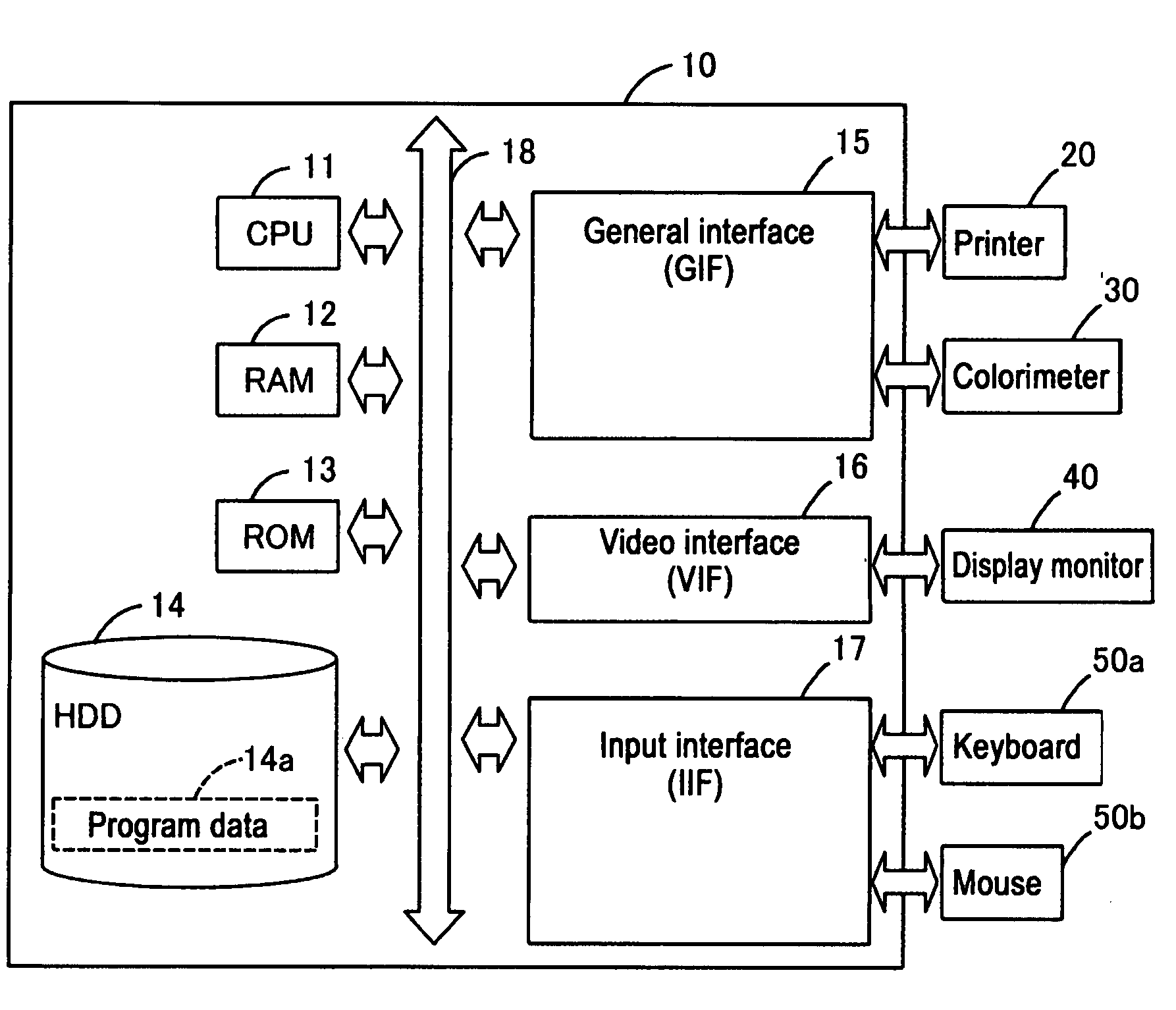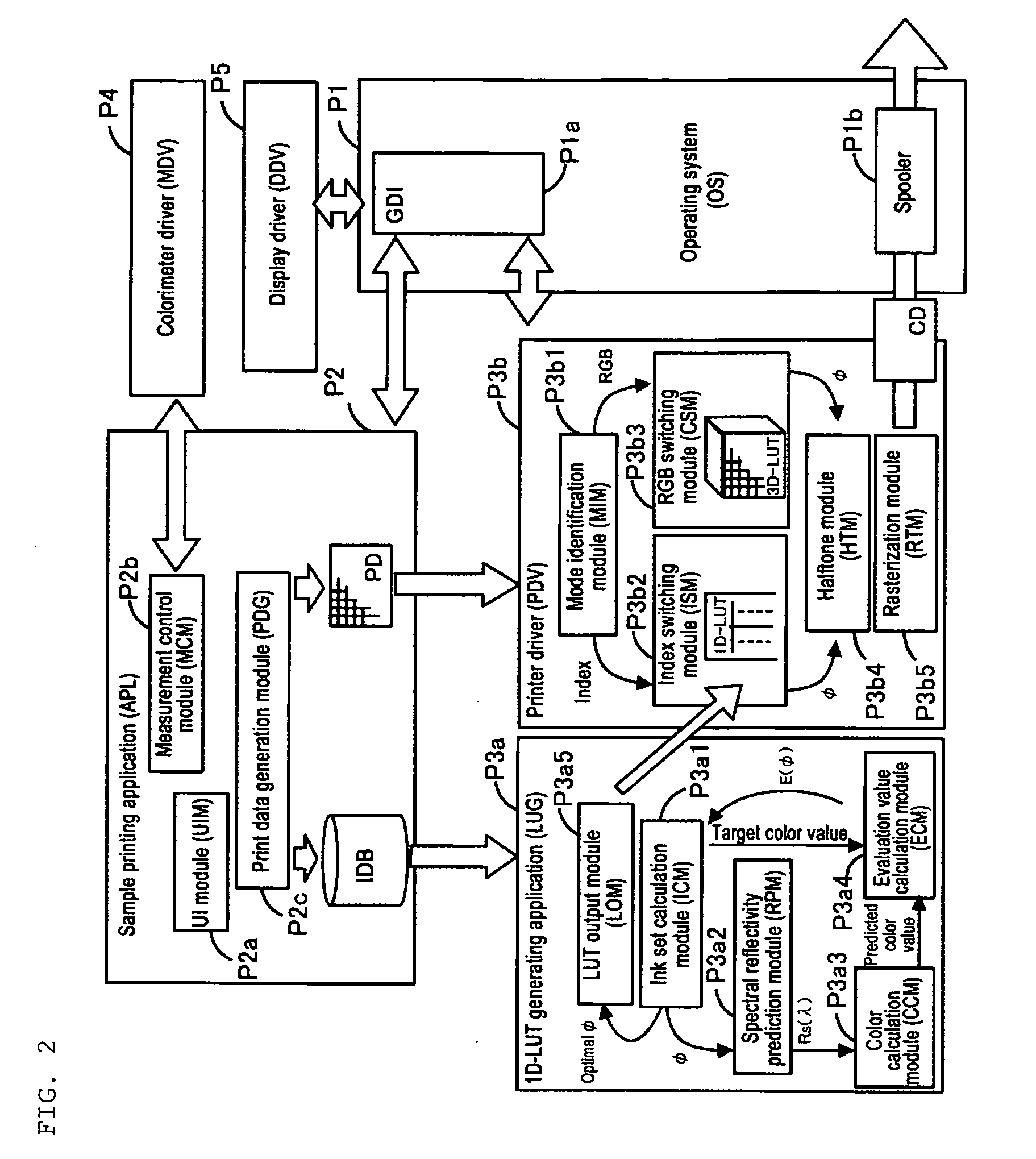Printing control device, print data generation device, printing system and printing control program
a printing control and data generation technology, applied in the direction of colour-separation/tonal correction, instruments, digitally marking record carriers, etc., can solve the problems of printing under unsuitable printing conditions, printer colors (the ink volumes of c, m, y, k, o and g) for achieving spectral reproducibility not necessarily optimal in relation to printing performance factors, and overall increase in the consumption of coloring materials such as ink, so as to achieve high spectral reprodu
- Summary
- Abstract
- Description
- Claims
- Application Information
AI Technical Summary
Benefits of technology
Problems solved by technology
Method used
Image
Examples
modification examples
5. MODIFICATION EXAMPLES
5-1. Modification Example 1
[0105]In Formula (2), the weighting coefficients for the light sources w1 to w5 are set to equal values, but it is also possible to the weighting coefficients w1 to w5 to different values. If the weighting coefficients w1 to w5 are set to larger values, then it is possible to raise the degree to which the color differences ΔED50, ΔED55, ΔED65, ΔEA, ΔEF11 of the corresponding light sources contribute to the increase in the evaluation value E(φ). Consequently, in order to minimize the evaluation value E(φ), it is necessary to ensure a particularly small value for the color differences ΔED50, ΔED55, ΔED65, ΔEA, ΔEF11 for those light sources which have been set to a high weighting coefficient w1 to w5, and by using an ink volume set φ which has been optimized on the basis of this evaluation value E(φ), it is possible to achieve printing which reduces the color differences ΔED50, ΔED55, ΔED65, ΔEA, ΔEF11 for the light sources which are s...
modification example 2
5-2. Modification Example 2
[0107]In the embodiment described above, the target color values of the target TG under the plurality of light sources are specified by means of a calorimeter 30, but it is also possible for the user to specify the target color values directly via the keyboard 50a, or the like. For example, if color value data obtained by previous color measurement of the target TG has already been prepared, or the like, then it is possible to specify the target color values by inputting this data. Moreover, since the target color values under the plurality of light sources can be calculated uniquely on the basis of the spectral reflectivity R(λ) of the target TG, then it is also possible to measure the spectral reflectivity R(λ) of the target TG by means of a spectral reflectometer instead of color measurement by a colorimeter 30 at step S140.
[0108]FIG. 20 shows a schematic view of the procedure for calculating the target color values in a case where the spectral reflecti...
modification example 3
5-3. Modification Example 3
[0109]FIG. 21 shows a schematic view of a case where the CCM P3a3 calculates predicted color values on the basis of the predicted spectral reflectivity Rs(λ) in a modification example. FIG. 21 shows the target spectral reflectivity Rt(λ) obtained in the modification example described above, and the correlation coefficients cx, cy, cz between this target spectral reflectivity Rt(λ) and the respective isochromatic functions x(λ), y(λ), z(λ) are calculated by the CCM P3a3. Since the isochromatic functions x(λ), y(λ), z(λ) respectively assume large values in different wavebands, then it can be considered that the correlation coefficients cx, cy, cz will become high when the waveband where the isochromatic function assumes a large value is similar to the target spectral reflectivity Rt(λ). The predicted color value according to the embodiment can be calculated by Formula (6) below.
Expression 6
[0110]
X=k∫P(λ)Rs(λ)cxx(λ)dλ
Y=k∫P(λ)Rs(λ)cyy(λ)dλ
Z=k∫P(λ)Rs(λ)czz(λ)dλ...
PUM
| Property | Measurement | Unit |
|---|---|---|
| volume | aaaaa | aaaaa |
| color | aaaaa | aaaaa |
| volumes | aaaaa | aaaaa |
Abstract
Description
Claims
Application Information
 Login to View More
Login to View More - R&D
- Intellectual Property
- Life Sciences
- Materials
- Tech Scout
- Unparalleled Data Quality
- Higher Quality Content
- 60% Fewer Hallucinations
Browse by: Latest US Patents, China's latest patents, Technical Efficacy Thesaurus, Application Domain, Technology Topic, Popular Technical Reports.
© 2025 PatSnap. All rights reserved.Legal|Privacy policy|Modern Slavery Act Transparency Statement|Sitemap|About US| Contact US: help@patsnap.com



